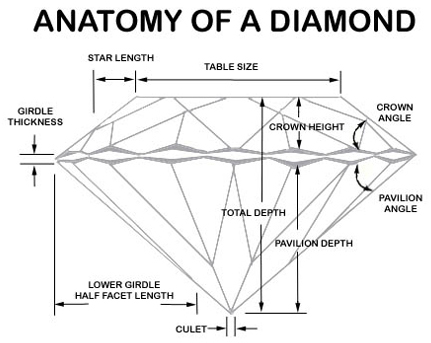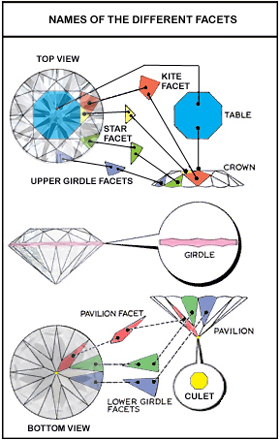Your Online Source for Wholesale Diamonds



| The Diamond Anatomy | |
|
About one ton of rubble is dug to recover less than half a Carat of Diamond Rough, making the diamond a vary rare gem. Something as beautiful as a Diamond can be found in the most remote and deepest places on earth. It is a testament of strength, endurance and the ultimate symbol of undying love, no doubt.
Each diamond is unique and each one reflects a story of its journey from the depths inside the earth into a treasured object of adornment. All diamonds share a certain feature that allows us to compare and differentiate them from one another. These are called the diamond 4Cs. | |
 | |
|
Diamond Table Size - is the length of the table of a diamond located at the top in the crown of a round brilliant diamond.
Girdle Thickness - is the thickness of the girdle, located at the side of the diamond where the upper girdle facets and lower girdle facets meet. Crown Height - the measurement from the girdle to the table of the diamond. Pavilion Depth - the measurement from the girdle to the culet (bottom tip of the diamond) of the diamond. Total Depth - Crown Height plus the Pavilion Depth Crown Angle - is the angle of the crown relative to the girdle. Pavilion Angle - is the angle of the pavilion relative to the girdle. Culet - bottom tip of a diamond. Star Length - the length of the star facet located at the crown. Half Facet Length - length of the pavilion facet. | |
|
Diamond Characteristics and Statistics
Element Composition: Carbon (C) Density: 3.51 g/cm3 (specific gravity = 3.51) Hardness: 10 on Mohs scale of mineral hardness which makes it only the hardest natural mineral. Colors: Colorless, yellow, brown, blue, pink Refractive Index: 2.4175 (in the yellow light of a sodium lamp) Optical Transmission: Transparent over broad spectrum of the electromagnetic spectrum, it is an excellent material for optical windows. Thermal Conductivity: Superb, 5 - 25 Watts/centimeter-degrees C (at 300 K), 4 times greater than copper which makes it an excellent thermal conductor. Electrical Conductivity: 0 to 100 ohm-cm (resistivity at 300 K), an insulator. Depending on the color of a diamond, it can also be a good conductor, colored diamonds have impurities in them which makes them great conductors. |  |
|
It is because of these qualities and characteristics are the reasons why diamonds are being used in several industries such as cutting, polishing, grinding and even drilling. Nowadays, diamonds are used in integrated circuits (IC) and even heat sinks in order to dissipate heat in electronics. Not to mention, it is very popular for wedding rings, diamond engagement rings and fine diamond jewelry especially.
| |
|
Upper Girdle Facets - these are facets located above the girdle and on the crown of a diamond Table - the flat surface located at the top of the diamond. Kite Facet - also located at the top of the round brilliant diamond and it looks like a kite, thus the name Kite Facet. See image above. Star Facet - still located at the top of the diamond but closer to the side or girdle of the diamond and adjacent to the Kite Facet. Girdle - at the side of the diamond where the upper girdle facets and lower girdle facets meet. This is where the laser inscription is done. Lower Girdle Facet - these are facets located below the girdle and on the pavilion of a diamond Pavilion Facet - are the facets located below the girdle of a diamond. Culet - the pointed part of a diamond located at the very bottom of a round brilliant diamond. | |